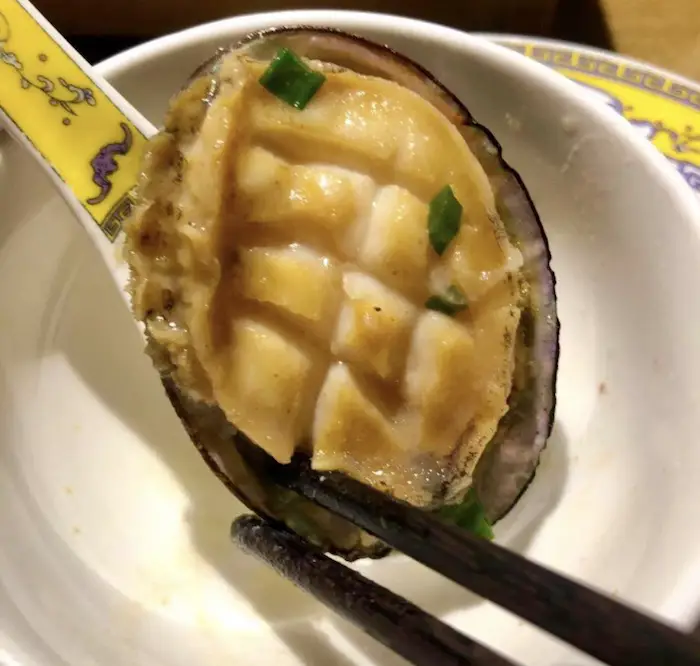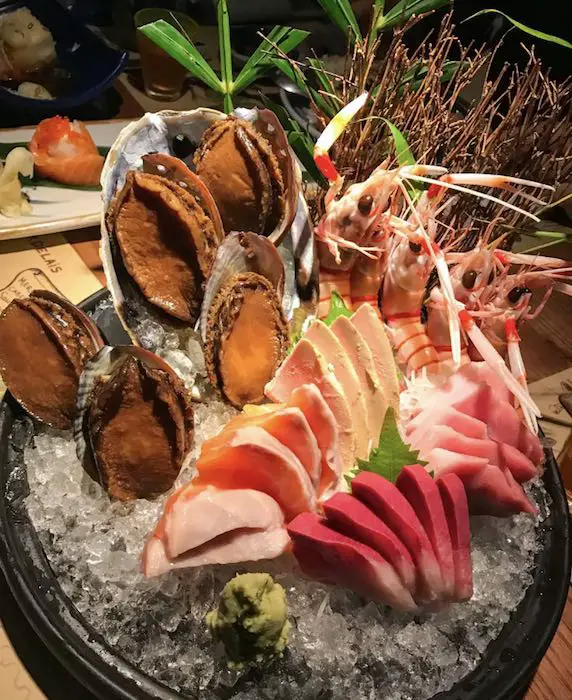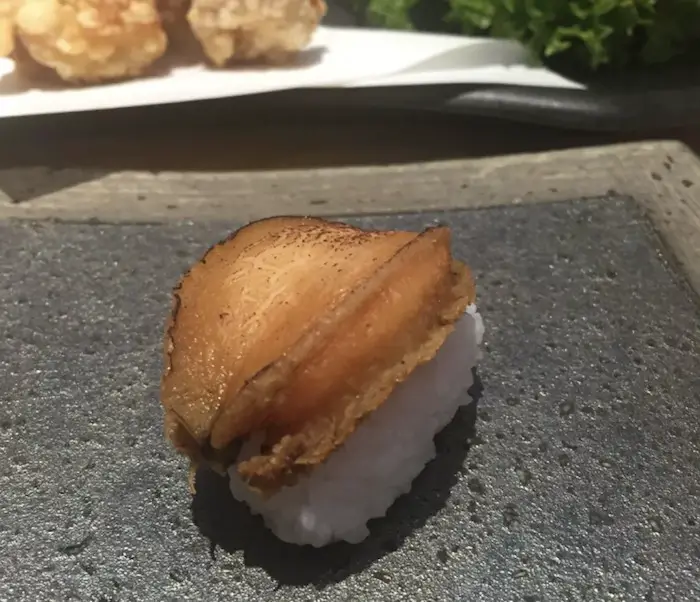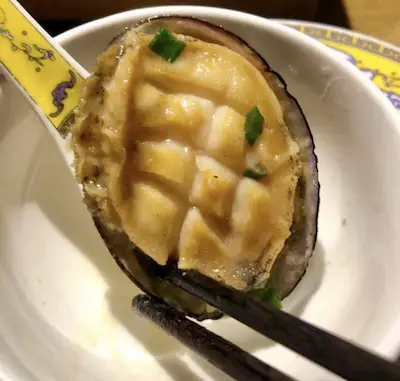We are reader supported. When you purchase through links on our site, we may earn an affiliate commission. Also, as an Amazon affiliate, we earn from qualifying purchases.

I am sure you know by now that the Japanese have a thing for raw seafood, and I have a fetish for exotic Japanese foods. One such rare and exotic cuisine is awabi, the Japanese word for abalone, which refers to the marine snail. Some common names of awabi in western countries are sea ears, ear shells, muttonfish or muttonshells, and paua.
Often called ‘the King of clams’, these sea snails mostly live in the sea around the archipelago at an approximate depth of 20 meters. The mollusks belong to the Halliotidae family and they are characterized by their bright colored shells containing the soft muscle within.
Abalones are herbivores that clamp on the aquatic plants with their muscular foot and feed on bits of kelp. They have a row of holes (tremata) along the edges of their shell to help them breathe. They are slow growing and it takes them nearly 5 years to become 4 inches in size.
Due to overfishing of these sea mollusks in Japan, the wild-bred awabi are getting close to extinction. As a result, the fully grown awabi has now become a rare and expensive delicacy. The fishermen require a valid license to be able to catch the marine snails from the ocean.
Considered as gourmet food in Japan, raw abalone reminds you of the ocean with its sea aroma, chewy texture, and delicate flavors. Besides being full of exotic sea flavors, awabi is also highly nutritious when eaten raw, baked, steamed or grilled.
Contents
An Early Summer Food
Awabi is essentially a sought after early summer delicacy for the Japanese and the name itself conjures up thoughts of May and June. It is similar to the way watermelon reminds people of midsummer in western countries.
Most other types of shellfish are available in the winter season and that is why awabi is so much associated with summer. In a high-quality sushi restaurant, you will be served raw awabi brushed with soy sauce or nitsume sauce on the top.
The itamae (chef) typically makes numerous slashes along the length of the meat, which makes it look like a measuring ruler. These cuts make the awabi easier to chew. The texture of the meat is slightly rubbery due to the toughness of meat, but the taste of subtle and delicate
If you are visiting a Japanese sushi restaurant, look for Mushi-awabi on the menu. In this dish, the abalone is steamed and then cooked in slow broth to bring out the umami flavors. While Mushi-awabi is rare to find, it gives you the authentic taste of Edo-period sushi.
If you are lucky enough to have a friendly itamae, ask him to serve you the muscular foot that holds on to the shell of awabi. This is the most delicious part and the chef may typically slice it horizontally for you to enjoy.
Awabi Used In Sushi And Sashimi

When consumed raw, awabi slices pair up beautifully with sushi rice and chefs prefer using wata (intestines and liver). If you are lucky enough to find a fishmonger in your area selling abalone, ask for the gut as it has a creamy consistency which balances the tough texture and gives your sushi a new dimension.
Interestingly, male abalone is a preferred choice when served raw \ and the female ones are mostly cooked or steamed. The main flesh part that is used as the nigiri topping comes from the foot muscle that allows abalone to move.
In Japanese sushi culture, abalone may be consumed raw, coiled, simmered, salted or steamed with soya sauce. When used as nigiri topping, it is mostly raw or live at times. The savory taste and rubbery texture make it perfect for raw consumption with sushi rice.
When awabi is served as sashimi, it is separated from its shell and thinly cut against the meat. Due to the firmness of meat, awabi may be lightly scored to improve the tenderness. Real fans of awabi sashimi prefer to eat the delicacy raw or e coat with soy sauce.
If you order awabi sushi at a restaurant for dinner, be prepared to shell out a lot of money as this cuisine is truly expensive. Live awabi used in sushi is of the highest grade and is often known as Ezo Awabi. It demands a special and respectable price tag. However, I can promise that it will be worth every penny.
Different Types Of Awabi
Ezo-awabi is the finest quality as mentioned above and they are tough to chew when eaten raw. It is also the most expensive of all varieties.
Kuro-awabi is the second best variety of abalone used in making sushi in Japan. The meat is cloudy gray in color and the surface of the flesh is blue-black.
Megai awabi has the softest flesh of all. It is either steamed or boiled during preparation. It is used in a variety of other dishes other than sushi.
Madaka awabi has brown-skinned meat that is slightly firmer. It tastes luscious and has a chewable texture. However, this type of awabi is available only in a few places in Japan. The sushi connoisseurs and amateurs in Japanese also import a lot of abalones from around the world.
Wild, Farmed, And Fake Awabi
Wild Awabi
Japan has the world’s most flourishing fisheries for the sea snail and they can also be found in the waters around the archipelago. It has remained a highly prized export item since centuries and was once comparable to precious metals.
However, overfishing soon caught up and wild awabi came near to extinction. As a result, the government had to interfere and put a stop on fishing of wild-bred awabi. The ones you get in the market today are farmed naturally.
In natural farming of awabi, the artificially bred young species are released into the specific restricted areas of the sea to be bred naturally. Despite the government interference, the demand and popularity of this sea snail remain the same and they are one of the most prized Japanese delicacy available.
As awabi exclusively breeds on seaweed in the natural habitat, they grow at a very slow rate and sometimes it takes about 20 years for them to reach an average size. Over-harvesting, on the other hand, may lead to substantial damage to the natural awabi habitats and it may take years to recover from such damages.
Awabi Farming
In some countries like America, wild shellfish such as clams, oysters, and awabi thrive on the ocean floor by filtering the seawater for food. They are often contaminated with toxic substances and heavy metals, hence it is against the law to sell or distribute shellfish as food.
The species that are sold in the supermarket or eaten at restaurants are usually farmed in controlled seawater and eaten at restaurants. Awabi farming is time-consuming and not a very financially fruitful business. Despite taking all measures for farming carefully, the growth rate of awabi is often very slow.
As per the FAO (Food and Agriculture Organization), Awabi is one of the most pricey seafood available worldwide. Recently, the production has shifted from wild fishing to farming and about 95% of the abalone available today comes from aquaculture alone.
China is the biggest producer of farmed abalones in the world and also remains the highest consuming nation. The Republic of Korea holds second place in terms of production and Australia is the third largest producer in the world.
Although the large size awabi are the most expensive, there is also a huge demand for the small sized ones to be used in sushi. Although small in size, they taste great and serve as the perfect topping for nigirizushi.
Fake Awabi
We have heard about all kind of substitutes from imitation crab meat to imitation lobsters. Now, here’s one more for you known as the Tokobushi, a shellfish that looks so similar to awabi that you cannot tell them apart.
Beginners usually think that tokobushi is the small version of awabi, however, this is not right. When compared to awabi, tokobushi contains less meat, has a flatter appearance and the shell has more holes in it. The appearance of meat and sea aroma is almost similar to abalone, however, the chewy texture and overall flavor are different.
If you find canned or frozen abalone sold at an unbelievably low price then it is probably ‘fake awabi’ such as rabasugai and korogai. Tokobushi is mostly used in simmered dishes whereas awabi or abalone is often served in sashimi style.
Preparing Awabi For Sushi/ Sashimi
This popular sea snail tastes fresh when out of the sea and has an amazing texture. The flesh may turn rubbery when it gets too old, hence I would recommend that you try to get it as fresh as possible. As the flesh is inside a shell, you need to first sprinkle some sea salt on it. This will make the snail tighten and shrink inside the shell.
Now use a sharp utensil such as a spatula or a spoon to take out the flesh from the shell. Do this carefully to ensure that you only get the flesh that separates from the filaments and entrails of the shell. Now, rinse the flesh clean by holding it under running tap water, scrub gently with a brush and pat dry.
Use a sharp Japanese knife to carefully make thin and horizontal slices of the flesh. Make sure you cut in a wavy motion to get it beautifully. The colored side of the awabi will be tough to cut so create a few incisions with the knife to make it easier to chew.
To serve as raw sashimi, add a splash of yuzu juice to the awabi slices and be prepared to fill your mouth with the ocean-like aroma. You may also add a bit of soya sauce to enhance the taste of raw abalone and bring out the umami flavors. The gut is the most prized part of the flesh. Squeeze some yuzu juice on it and take a savory bite.
If you are using frozen awabi for your sashimi or sushi, you will need to put the chunks on a steamer on full blast to thaw the meat completely. You will need to steam again slowly, this time with salt water to enhance the flavor.
Awabi (Abalone) Nigiri Sushi
As mentioned above, awabi is mostly eaten as sashimi or in the form of nigiri sushi. To make nigirizushi, you will first need to prepare sushi rice. Find step by step instructions on how to make sushi rice in a cooker or pot here.
After sushi rice is cooked, you will need to season it with vinegar, sugar, and salt. Now, take a medium ball of sushi rice and make an oblong shape using your fingers. Make a slight dent at the bottom of the rice bed so that there’s a hump on the top.

Now, place the awabi (slice) on the bed of rice and again use your fingers to press and give them shape. You may use a small Nori strip to bind them together. Serve with soy sauce and pickled ginger.
How To Cook Awabi (Abalone)
This Japanese delicacy is usually eaten raw with sushi, however, it may sometimes be cooked or steamed to bring out the flavors. If you are new to eating raw seafood and find it intimidating, you may cook awabi and enjoy it in a bowl of charishi. Here’s the recipe:
- 2 medium-sized awabi/abalone
- 2 tbsp dashi stock
- 2 tbsp shoyu or soy sauce
- 1 sheet of konnyaku
- Sesame oil, as required
- 1 tbsp Japanese sake or rice wine
- 2 tbsp mirin or Japanese rice wine
- Shichimi Togarashi (a blend of red pepper and other spices)
Steam cook awabi pieces by steeping them in Japanese sake for 10-15 minutes only. Remember to not overcook as this can spoil the texture. Now, cut the awabi and konnyaku into bite-size pieces using a sharp knife.
Heat some sesame oil in a frying pan and stir-fry the pieces. Add some dashi stock and Japanese sake. Bring to boil and let the alcohol evaporate. Now, add Shichimi Togarashi, shoyu sauce, and mirin. Simmer for 5 minutes.
Related Questions
Which countries are the largest producers of cultured abalone?
Countries like South Africa, Chile, Taiwan, Iceland, and Mexico are the largest producers of cultured abalone.
Is there a demand for shells too?
While there is a huge demand for abalone flesh or meat, the shells are also used in making jewelry items as they are vibrant and look beautiful.
How long does it take for the sea snails to become market ready?
They are slow growing and usually takes between 3 to 5 years for the snails to become big enough to be sold in the market for consumption.
Is abalone fishing illegal?
It is considered illegal to catch abalone directly from the ocean as their numbers have dwindled significantly in the past few years. Poaching is one of the biggest threats to these sea mollusks as locals continue to illegally export overseas.
See Also:
What’s In A Philadelphia Roll And How To Make It:
How Much Do Sushi Chefs Make In Japan?
What Is Oshinko And How To Make Oshinko Sushi Roll?

